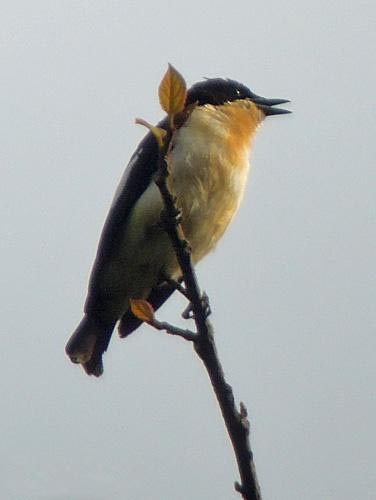
a web page by Don Roberson |
HYLIOTAS Hyliotidae |
|
To some extent, hyliotas are 'flycatcher-like' as they occasionally snatch insects in flight, but they are actually gleaners in the canopy, searching the undersides of leaves and branches, even hanging upside down to do so at times. They are found in pairs and small family parties; it appears that this year's young stay with the parents until the next breeding time. All four species are canopy species for the most part, but Southern Hyliota (left, a very fine shot by Nik Borrow) is a bird of the stunted canopy of Brachystegia and other miombo woodlands (Urban et al. 1997). It has a very patchy distribution from Mozambique and Zimbabwe north to Angola and the Congo Basin, with an isolated population in the Mt. Kupe area of Cameroon. Family parties maintain permanent territories, but they often join mixed-species foraging flocks with eremomelas, crombecs, Brubru Nilaus after, weavers, and small woodpeckers. |
The other two species are much more restricted in range. Usambara Hyliota Hyliota usambara is endemic only to the Usambara Mountains of eastern Tanzania, where it is a canopy bird of montane forests. Violet-backed Hyliota H. violacea inhabits lowland forest (especially edges) in west Africa, Gabon, and parts of the Congo Basin. |
Writing the in mid-1990s before any genetic work, Urban et al. (1997) wrote of the taxonomic uncertainty about these birds at that time: "Small birds of woodland canopy with rather slender and flat bill, exposed nostrils, rather long tarsus and pointed wings. Forage like a warbler (e.g., Eremomela) but have flycatcher-like plumage with platysteirid pattern. Nestling has mouth spots; juvenile plumage not spotted; adult male plumage matt or glossy blue-black above, creamy to rusty below, with white panel in wing; things black; rump feathers rather fully with white spots at base. Travel in family parties and may prove to be cooperative breeders . . . Mouth spot, unspotted juveniles and foraging behaviour are warbler characters. Adult plumage pattern, colour and quality are very like some Ficedula flycatchers, but even more like Platysteiridae. Nidification is platysteirid. Hyliota might even turn out to be a diminutive malaconotid shrike. DNA studies would be most revealing." There were. Hyliota is an ancient clade of early passerida birds, not really closely related to much of anything else; Fuchs et al. (2006). They were enigmatic for a reason — they are unique. |
Photos: Nik Borrow photographed the Southern Hyliota Hyliota australis on Mt. Kupe, Cameroon, on 31 Mar 2012. Matthew Matthiessen photographed the Yellow-bellied Hyliota Hyliota flavigaster at Ngaoundaba Ranch, Cameroon, on 14 Apr 2006. Photos © Nik Borrow and © Matthew Matthiessen, used with permission; all rights reserved. Photographer/author/tour leader Nik Borrow has a web site full of photos; many Matthew Matthiessen photos appear on-line, including the Rockjumper tours web site. Bibliographic note: There is no "family book" per se, but a fine introduction to this small family, with some photos, is in Bairlein (2006). Literature cited:
|
 Hyliotas
are a small family of enigmatic passerines, primarily in west and
central Africa. They are composed of just four species in a single
genus (Hyliota). At various times they were assigned to the
Old World flycatcher (Muscicapidae), or monarch flycatchers
(Monarchidae), or batises and wattle-eyes (Platysteiridae), but most
often they were thrown in among the Old World warblers (Sylviidae).
Fuchs et al. (2006) showed that they were not particularly related to
sylvids, and shortly thereafter the entire "Old World warblers" were
Hyliotas
are a small family of enigmatic passerines, primarily in west and
central Africa. They are composed of just four species in a single
genus (Hyliota). At various times they were assigned to the
Old World flycatcher (Muscicapidae), or monarch flycatchers
(Monarchidae), or batises and wattle-eyes (Platysteiridae), but most
often they were thrown in among the Old World warblers (Sylviidae).
Fuchs et al. (2006) showed that they were not particularly related to
sylvids, and shortly thereafter the entire "Old World warblers" were  Yellow-bellied Hyliota
(right, a nice photo by Matthew Matthiessen) is a also a bird of
woodland canopy, but these tend to be taller trees in wooded savanna.
It has the most widespread range of any hyliota, in an expansive swathe
of wooded savanna from west Africa to Ethiopia, and again across
African south of the Congo Basin from Angola to Mozambique, and in East
Africa away from the coast. It, too, joins mixed-species foraging
flocks.
Yellow-bellied Hyliota
(right, a nice photo by Matthew Matthiessen) is a also a bird of
woodland canopy, but these tend to be taller trees in wooded savanna.
It has the most widespread range of any hyliota, in an expansive swathe
of wooded savanna from west Africa to Ethiopia, and again across
African south of the Congo Basin from Angola to Mozambique, and in East
Africa away from the coast. It, too, joins mixed-species foraging
flocks.